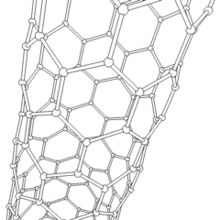Familiarity with the characteristics of electronic transmission or conductivity of nanotubes (single and multi-walled) CNTs and CNTs (based on PhD in nano-microelectronics)
Researcher and author: PhD student Afshin Rashid
Note: In the case of electronic transmission and conduction , different molecules on the surface of CNTs nanotubes have similar conditions in terms of the length of SWCNTs and their hardness. There are many properties and applications of carbon nanotubes that take full advantage of CNTs aspect ratio, mechanical strength, electrical and thermal conductivity.
Electronic conductivity can affect some of the intrinsic properties of these nanotubes . Heat treatment on nanotubes reduces the number of structural defects in nanotubes, which are caused by purification or catalyst particles. After heat treatment, the electronic spectrum of CNT single-walled carbon nanotubes loses its sensitivity to electronic conductivity, while it is sensitive to the electronic evolution of carbon nanotube particles in the mode of transmission or electrical conductivity . Therefore, some intrinsic properties for pure nanotubes or those that are slightly heated are subjected to the reaction of electromagnetic particles and the increase in conductivity in the state of potential conductivity and electron conduction.
In nanoelectronics, he used the arc method to produce carbon nanotubes. This method uses an almost low voltage source to create a spark between the two electrodes. Intermediate metal catalysts are added to the graphite anode to accelerate the production of carbon nanotubes. Nanotubes can usually be added to their mass to improve the electrical properties of some materials, such as GCE (carbon glass electrodes) , carbon paste electrodes, graphite electrodes, or graphene electrodes . In general, it has been observed that the addition of nanoparticles into the structure of the electrodes leads to improved electrochemical properties, higher sensitivity and less diagnostic limitations . In addition, in nano- electrochemical detection methods , the use of nanostructures generally causes Improves charge transfer at the electrode surface.
Conclusion :
In the case of electronic transmission and conduction , different molecules on the surface of CNTs nanotubes have similar conditions in terms of SWCNT length and stiffness. There are many properties and applications of carbon nanotubes that take full advantage of CNTs aspect ratio, mechanical strength, electrical and thermal conductivity.
Author: PhD student ( Afshin Rashid)




